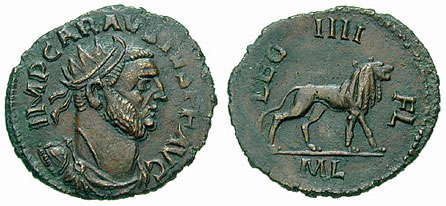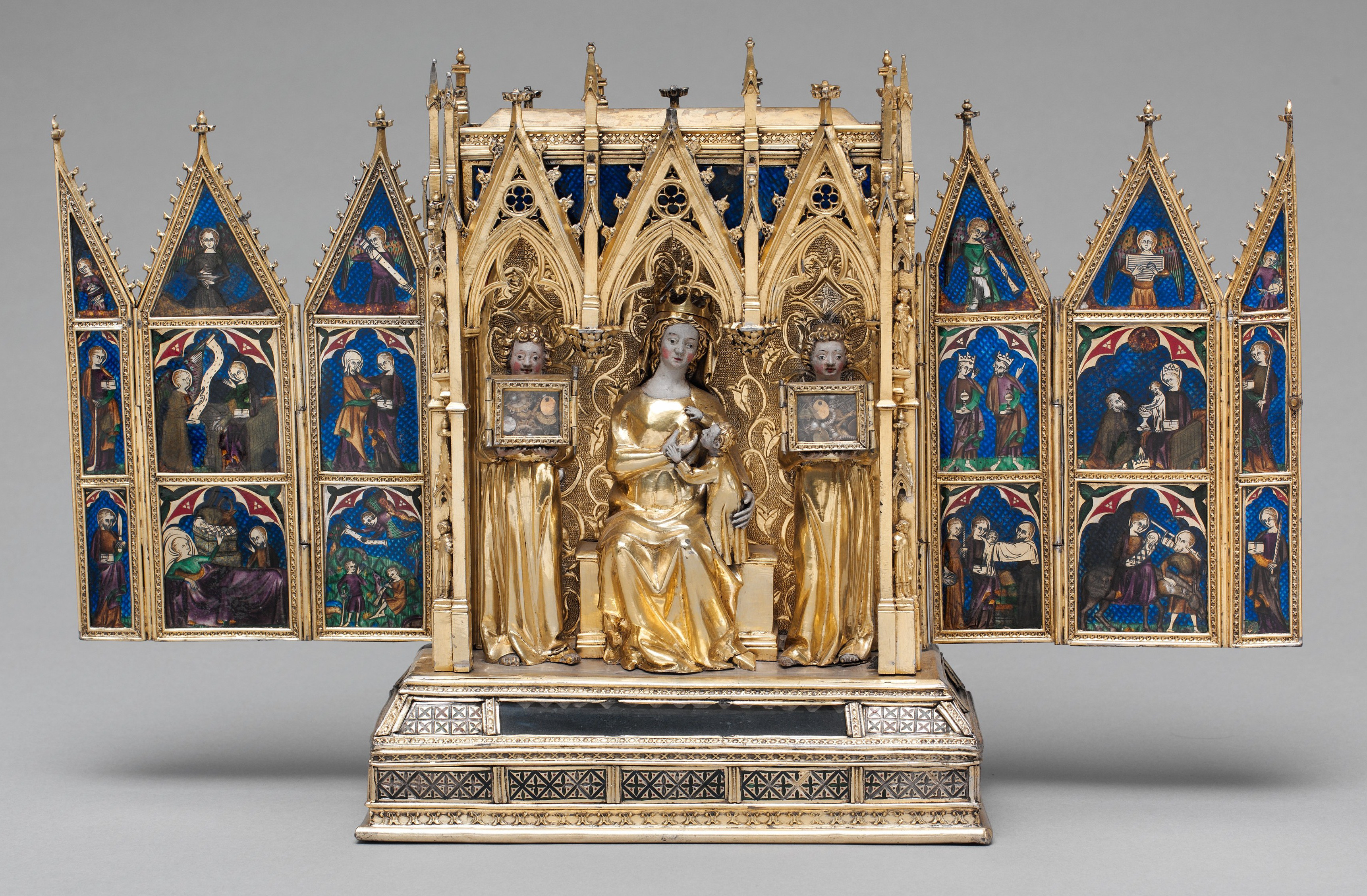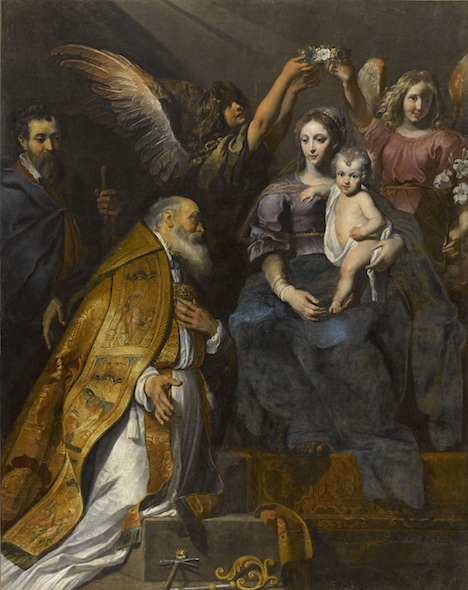|
Piatus Of Tournai
Piatus of Tournai (also Piaton, Platon, Piat, Piato) (died c. 286) was a Belgian saint. He was a native of Benevento, Italy, and is traditionally said to have been sent by the pope to evangelize the cities of Chartres and Tournai. Tradition also states that he was ordained by Dionysios the Areopagite. He was martyred under Maximian by having the top of his skull sliced off. He may be recognized in depictions holding the sliced portion of his skull. Eligius later discovered Piatus' relics and made a reliquary for them. Some of his relics can be found at Chartres Cathedral. Gallery Image:Tournai - Eglise Saint-Piat.jpg, Church of Saint-Piat, Tournai Image:Chartres Chorapsiden.jpg, Chapel of Saint-Piat, Chartres Cathedral Chartres Cathedral (, lit. Cathedral of Our Lady of Chartres) is a Catholic cathedral in Chartres, France, about southwest of Paris, and is the seat of the List of bishops of Chartres, Bishop of Chartres. Dedicated in honour of the Virgin Mary ( ... Image:Cha ... [...More Info...] [...Related Items...] OR: [Wikipedia] [Google] [Baidu] |
October 1 (Eastern Orthodox Liturgics)
September 30 - Eastern Orthodox liturgical calendar - October 2 All fixed commemorations below celebrated on ''October 14'' by Eastern Orthodox Churches on the Old Calendar. For October 1st, Orthodox Churches on the Old Calendar commemorate the Saints listed on ''September 18''. Feasts * ''The Protection of Our Most Holy Lady Theotokos and Ever-Virgin Mary, at the Blachernae church in Constantinople'' (911) ''(see also: October 28 - Greek Orthodox Church)'' Saints * ''Saint Ananias of Damascus, Bishop and one of the Seventy Apostles'' (1st century) * Martyr Domninus of Thessalonica (4th century) * Ezana of Axum, king of Ethiopia (4th century). * King Mirian III of Iberia (c. 361) and Queen Nana of Mtskheta (c. 364) - Equals-of-the-Apostles, St. Abiathar of Mtskheta, and St. Sidonia, disciple of St. Nina (4th century) October 1/14 ... [...More Info...] [...Related Items...] OR: [Wikipedia] [Google] [Baidu] |
Maximian
Maximian (; ), nicknamed Herculius, was Roman emperor from 286 to 305. He was ''Caesar (title), Caesar'' from 285 to 286, then ''Augustus (title), Augustus'' from 286 to 305. He shared the latter title with his co-emperor and superior, Diocletian, whose political brain complemented Maximian's military brawn. Maximian established his residence at Trier but spent most of his time on campaign. In late 285, he suppressed rebels in Gaul known as the Bagaudae. From 285 to 288, he fought against Germanic tribes along the Rhine frontier. Together with Diocletian, he launched a scorched earth campaign deep into Alamannic territory in 288, refortifying the frontier. The man he appointed to police the English Channel, Channel shores, Carausius, rebelled in 286, causing the secession of Britain and northwestern Gaul. Maximian failed to oust Carausius, and his invasion fleet was destroyed by storms in 289 or 290. Maximian's subordinate Constantius Chlorus, Constantius campaigned against Cara ... [...More Info...] [...Related Items...] OR: [Wikipedia] [Google] [Baidu] |
Italian Saints
Italian(s) may refer to: * Anything of, from, or related to the people of Italy over the centuries ** Italians, a Romance ethnic group related to or simply a citizen of the Italian Republic or Italian Kingdom ** Italian language, a Romance language *** Regional Italian, regional variants of the Italian language ** Languages of Italy, languages and dialects spoken in Italy ** Italian culture, cultural features of Italy ** Italian cuisine, traditional foods ** Folklore of Italy, the folklore and urban legends of Italy ** Mythology of Italy, traditional religion and beliefs Other uses * Italian dressing, a vinaigrette-type salad dressing or marination * Italian or Italian-A, alternative names for the Ping-Pong virus, an extinct computer virus * ''Italien'' (magazine), pro-Fascist magazine in Germany between 1927 and 1944 See also * * * Italia (other) * Italic (other) * Italo (other) * The Italian (other) * Italian people (other) Italian ... [...More Info...] [...Related Items...] OR: [Wikipedia] [Google] [Baidu] |
Belgian Saints
{{Disambiguation ...
Belgian may refer to: * Something of, or related to, Belgium * Belgians, people from Belgium or of Belgian descent * Languages of Belgium, languages spoken in Belgium, such as Dutch, French, and German *Ancient Belgian language, an extinct language formerly spoken in Gallia Belgica *Belgian Dutch or Flemish, a variant of Dutch *Belgian French, a variant of French *Belgian horse (other), various breeds of horse *Belgian waffle, in culinary contexts * SS ''Belgian'', a cargo ship in service with F Leyland & Co Ltd from 1919 to 1934 *''The Belgian'', a 1917 American silent film See also * *Belgica (other) *Belgic (other) Belgic may refer to: * an adjective referring to the Belgae, an ancient confederation of Celto-Germanic tribes * a rarer adjective referring to the Low Countries or to Belgium * , several ships with the name * Belgic ware, a type of pottery * Bel ... [...More Info...] [...Related Items...] OR: [Wikipedia] [Google] [Baidu] |
People From Benevento
The term "the people" refers to the public or common mass of people of a polity. As such it is a concept of human rights law, international law as well as constitutional law, particularly used for claims of popular sovereignty. In contrast, a people is any plurality of persons considered as a whole. Used in politics and law, the term "a people" refers to the collective or community of an ethnic group or nation. Concepts Legal Chapter One, Article One of the Charter of the United Nations states that "peoples" have the right to self-determination. Though the mere status as peoples and the right to self-determination, as for example in the case of Indigenous peoples (''peoples'', as in all groups of indigenous people, not merely all indigenous persons as in ''indigenous people''), does not automatically provide for independent sovereignty and therefore secession. Indeed, judge Ivor Jennings identified the inherent problems in the right of "peoples" to self-determination, as i ... [...More Info...] [...Related Items...] OR: [Wikipedia] [Google] [Baidu] |
286 Deaths
__NOTOC__ Year 286 ( CCLXXXVI) was a common year starting on Friday of the Julian calendar. At the time, it was known as the Year of the Consulship of Maximus and Aquilinus (or, less frequently, year 1039 ''Ab urbe condita''). The denomination 286 for this year has been used since the early medieval period, when the Anno Domini calendar era became the prevalent method in Europe for naming years. Events By place Roman Empire * Winter/Spring: The ''Caesar'' Maximian defeats the Bagaudae rebellion in Gaul. He then defeats a Germanic invasion into Gaul, defeating an army of Burgundians and Alemanni and another army of Chaibones and Heruli. * Emperor Diocletian campaigns successfully against Sarmatian raids. The future emperor Constantius defeats the 'Bosporian Sarmatians'. * April 1 – Diocletian rewards Maximian by elevating him to co-emperor, giving him the title Augustus. * Summer: Carausius, commander of the ''Classis Britannica'', is accused of piracy by Maximi ... [...More Info...] [...Related Items...] OR: [Wikipedia] [Google] [Baidu] |
3rd-century Births
The 3rd century was the period from AD 201 (represented by the Roman numerals CCI) to AD 300 (CCC) in accordance with the Julian calendar. In this century, the Roman Empire saw a crisis, starting with the assassination of the Roman Emperor Severus Alexander in 235, plunging the empire into a period of economic troubles, barbarian incursions, political upheavals, civil wars, and the split of the Roman Empire through the Gallic Empire in the west and the Palmyrene Empire in the east, which all together threatened to destroy the Roman Empire in its entirety, but the reconquests of the seceded territories by Emperor Aurelian and the stabilization period under Emperor Diocletian due to the administrative strengthening of the empire caused an end to the crisis by 284. This crisis would also mark the beginning of Late Antiquity. While in North Africa, Roman rule continued with growing Christian influence, particularly in the region of Carthage. In Persia, the Parthian Empire was suc ... [...More Info...] [...Related Items...] OR: [Wikipedia] [Google] [Baidu] |
Chartres Cathedral
Chartres Cathedral (, lit. Cathedral of Our Lady of Chartres) is a Catholic cathedral in Chartres, France, about southwest of Paris, and is the seat of the List of bishops of Chartres, Bishop of Chartres. Dedicated in honour of the Virgin Mary ('Our Lady'), it was mostly constructed between 1194 and 1220. It stands on the site of at least five cathedrals that have occupied the site since the Diocese of Chartres was formed as an episcopal see in the 4th century. It is one of the best-known and most influential examples of High Gothic and Classic Gothic architecture. It was built above earlier Romanesque architecture, Romanesque basements, while its north spire is more recent (1507–1513) and is built in the more ornate Flamboyant style. "[O]ne of the most beautiful and historically significant cathedrals in all of Europe," it was designated a World Heritage Site by UNESCO in 1979, which called it "the high point of French Gothic architecture, French Gothic art" and a "masterpiece ... [...More Info...] [...Related Items...] OR: [Wikipedia] [Google] [Baidu] |
Reliquary
A reliquary (also referred to as a ''shrine'', ''Chasse (casket), chasse'', or ''phylactery'') is a container for relics. A portable reliquary, or the room in which one is stored, may also be called a ''feretory''. Relics may be the purported or actual physical remains of saints, and may comprise bones, pieces of clothing, or some object associated with saints or with other religious figures. The authenticity of any given relic is often a matter of debate; for that reason, some churches require documentation of a relic's provenance. Relics have long been important to Buddhism, Buddhists, Christianity , Christians, Hinduism , Hindus, and to followers of many other religions. These cultures often display reliquaries in shrines, churches, or temples to which the faithful make pilgrimages to gain blessings. The term is sometimes used in a looser sense to mean a container for the remains of any important figure, even non-religious ones. In particular, the kings of France often spe ... [...More Info...] [...Related Items...] OR: [Wikipedia] [Google] [Baidu] |
Relics
In religion, a relic is an object or article of religious significance from the past. It usually consists of the physical remains or personal effects of a saint or other person preserved for the purpose of veneration as a tangible memorial. Relics are an important aspect of some forms of Buddhism, Christianity, Islam, shamanism, and many other religions. ''Relic'' derives from the Latin ''reliquiae'', meaning "remains", and a form of the Latin verb ''relinquere'', to "leave behind, or abandon". A reliquary is a shrine that houses one or more religious relics. In classical antiquity In ancient Greece, a city or sanctuary might claim to possess, without necessarily displaying, the remains of a venerated hero as a part of a hero cult. Other venerable objects associated with the hero were more likely to be on display in sanctuaries, such as spears, shields, or other weaponry; chariots, ships or figureheads; furniture such as chairs or tripods; and clothing. The sanctuary of th ... [...More Info...] [...Related Items...] OR: [Wikipedia] [Google] [Baidu] |
Saint Eligius
Eligius (; 11 June 588 – 1 December 660), venerated as Saint Eligius, was a Frankish goldsmith, courtier, and bishop who was chief counsellor to Dagobert I and later Bishop of Noyon–Tournai. His deeds were recorded in ''Vita Sancti Eligii'', written by his friend Audoin of Rouen. Born into a Gallo-Roman family, Eligius found success as a goldsmith at the Merovingian royal court of Clotaire II and served as chief counsellor to Dagobert I until Dagobert's death in 639. Under the subsequent regency of Nanthild, the queen consort, Eligius was ordained a priest and campaigned against simony in the Church. Appointed Bishop of Noyon–Tournai in 642, he founded many monasteries and churches while working to convert the pagan population of Flanders to Christianity. Despite his background as a goldsmith, Eligius became increasingly ascetic during his time at the royal court and used his influence to ransom captive slaves and care for the poor. A legend emerged of him once he ... [...More Info...] [...Related Items...] OR: [Wikipedia] [Google] [Baidu] |






